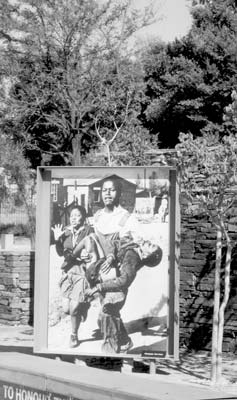You simply must visit South Africa
by Philip Wagenaar, first of three parts
“You now have to set your watch one hundred years back,” the captain announced as the plane descended toward the Johannesburg airport.
Just a few weeks earlier a screaming headline in the newspaper The Cape Times had proclaimed, “Never would a colored heart beat in a white neighborhood.” A Jew had just received a colored man’s heart in the second transplant performed by Prof. Christiaan Barnard at Groote Schuur Hospital in Cape Town. Had the recipient survived, he would have been unable to live anywhere in South Africa.
After all, it was 1971 and apartheid was rife. Races were segregated. Blacks and coloreds lived in townships under indescribable conditions, and the hated “pass laws” allowed only people who worked in a municipality access to it. As a result, many families were separated.
In addition, households were disrupted if one of its members happened to look darker than the others. If in doubt about the color, the so-called pencil test determined where a person would live. If it stuck in the curly hair rather than falling out, the person would be considered black and had to reside in the black township.
In 1971, Flory and I rented a car and drove for three weeks through South Africa. Starting in Johannesburg, we traveled via Kruger Park and Swaziland to Durban. From there, we drove along the coast to Cape Town.
In March 2003 I went on a press tour of South Africa as the guest of South African Tourism (SAT) and South African Airways (SAA).
Conditions certainly have changed. The post-apartheid constitution has granted equal rights to all citizens, and the country once again is a worthwhile and inexpensive tourist destination. Although all is not well and many blacks still reside in abominable surroundings, races now mix freely. No more signs reading “Whites only.”
South African Airways
SAA provided our group of journalists with complimentary business-class transportation. The nicely appointed lounge at New York’s JFK made our predeparture wait painless, and a smiling cabin crew and excellent service made the time pass quickly during the 15½-hour flight.
SAA is the only company offering a nonstop schedule from the USA to South Africa, with flights departing daily from Atlanta to either Johannesburg or Cape Town and five times weekly from New York’s JFK to Johannesburg.
You won’t be disappointed when you use this airline.
For flights inside the country and to Botswana and Namibia, use pleasant South African Express with its modern regional jets and turboprops.
In 2001, Zagat Survey listed South African Airways as one of the “Top 10 International Airlines.” Amazingly, the airline has been making a profit all along. Call SAA at 800/722-9675, e-mail help@flysaa.com or visit www.saa.co.za/saa_home.jhtml.
Johannesburg
Our tour started in Johannesburg, a nondescript, Western-style city with lots of concrete buildings.
Since all of us wanted to see its crime-infested core, we literally begged our guide to drive through it. To us, the Carlton Center and the Braamfontein and Hillbrow sections didn’t look much different from other districts, but our driver told us that getting out of the car was synonymous with being mugged. Even the police do not like to go there.
Not very far from the center, we passed the enormous mansions of the super-rich, who live cocooned inside their gardens enclosed by high, barbed-wire-topped walls and guarded by elaborate security systems augmented by ferocious dogs. The lesser-endowed live nearby in small apartments or modest houses.
Businesses and hotels have moved to northern suburbs, such as Sandton and Rosebank where the ambiance and the malls resemble those of any bedroom community. Only the neat, wide, tree-lined streets and the 80-degree March temperature made me appreciate the difference.
SAT put us up in the lovely, 5-star Grace Hotel (54 Bath Avenue, Rosebank 2196, Johannesburg, South Africa; phone 011/27/11 280-7200, fax 011/27/11 280-7474, e-mail graceres@grace.co.za or log on to www.grace.co.za/the_grace/contact.html), where the room, service and meals were outstanding. You will never be hungry at the Grace, as tea, coffee and cakes are served free of charge from 6 a.m. until 5 p.m. and gratis canapès wink at you at cocktail time.
On a B&B basis, the cost of a single room is 2,100 rand (approximately $262) — worth it for those who are willing to spend the money. I do recommend this establishment highly.
Except for a visit to Soweto, there is not much to see in Johannesburg. Soweto, an acronym for South Western Township, was the place where the black population had to live under the notorious Group Areas Act.
Soweto’s appearance hasn’t changed much since 1971. Millionaires in opulent houses still live next to residents in the most abominable shacks, while middle-income houses with tiny gardens lie scattered helter-skelter throughout the sprawling township.
Safety
Well, you ask, is it safe to visit South Africa?
My answer is “Yes, it is safe as long as you keep away from the high-crime areas, wear a money belt at all times and don’t flash valuables.”
If you don’t mind driving on the left side, a rental car is a good option.
I suggest that you read all the warnings in the Lonely Planet guide “South Africa, Lesotho & Swaziland” before leaving.
When to go
The best times to go are spring and fall (remember, the seasons are reversed). Avoid school holidays and the period from mid-December to late January when South Africans take their vacations. In many places, it is too hot then anyway.
For more information, contact South African Tourism (500 Fifth Ave, Ste. 2040, New York, NY 10110; phone 800/822-5368, fax 212/764-1980, e-mail newyork@southafrica.net or visit www.southafrica.net).
Next month, I will relate our trip on the upscale Blue Train, which took us to Cape Town, and give you my impressions of that magnificent city.
Philip Wagenaar was a guest of South African Tourism and South African Airways.

